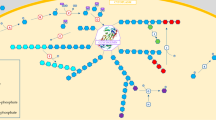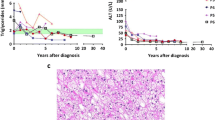Abstract
Our objective was to evaluate the long-term effects of dietary therapy of tyep I glycogen storage disease which avoids increased lactate production during childhood and adolescence. In order to suppress hepatic glucose and increased lactate production consistently day and night, the treatment regimen included nocturnal intragastric feeding of glucose polymer during childhood and adolescence. The aim was to keep the blood glucose concentration in the “high normal range” (4.3–5.5 mmol/l) and the lactate concentration in urine in the normal range (<0.06 mol/mol creatinine). The amounts of dietary carbohydrate required decreased in an age-related manner from 11.9±1.3 mg/kg body weight per min by day and 6.9±0.9 mg/kg body weight per min by night at 1 year of age to 5.2±1.0 and 2.9±1.2 mg/kg body weight per min, respectively, at the age of 16 years. In 15 infants, therapy started at 5.8±3.2 months of age and induced catch up growth over 1–2 years by which time the mean height SDS increased from −1.02±0.91 to −0.19±1.07. In the well controlled patients, further growth continued within that range. From 12 years of age, mean height SDS was in line with the respective mean SDS of mid-parental target height. The plasma lipid concentrations were markedly reduced, but were not brought into the normal range. So far, no adolescent showed liver adenoma or renal damage. Four patients with poor metabolic control due to poor compliance with treatment (frequently subnormal plasma glucose concentrations, severe hypoglycaemia, and increased urinary lactate excretion) showed retardation of growth and bone maturation.Conclusion: avoiding increased lactate production by keeping the blood glucose concentration permanently in the “high normal range” seems to be crucial for growth according to the genetic potential.
Similar content being viewed by others
Abbreviations
- BMI :
-
body mass index
- G6Pase :
-
glucose-6-phosphate
- GSD :
-
glycogen storage disease
- SDS :
-
standard deviation score
- SDSCA :
-
standard deviation score for chronological age
References
Bier DM, Leake RD, Haymond MW, Arnold KJ, Gruenke LD, Sperling MA, Kipnis DM (1977) Measurement of “true” glucose production rates in infancy and childhood with 6,6 dideutero-glucose. Diabetes 26: 1016–1023
Chen Y-T, Burchell A (1995) Glycogen storage diseases. In: Scriver C, Beaudet A, Sly W, Valle D (eds) The metabolic and molecular bases of inherited disease, 7th edn. McGraw-Hill, New York, pp 935–965.
Chen Y-T, Cornblath M, Sidbury JB (1984) Cornstarch therapy in type I glycogen-strorage disease. N Engl J Med 310: 171–175
Chen Y-T, Bazzarre CH, Lee MM, Sidbury JB, Coleman RA (1993) Type I glycogen storage disease: nine years of management with cornstarch. Eur J Pediatr 152[Suppl 1]: S56-S59
Dionisi Vici C, Bartuli A, Mazziotta MRM, Sabetta G (1990) Early introduction of uncooked cornstarch for the treatment of glycogen storage disease type I. Acta Paediatr Scand 79: 978–979.
Fernandes J, Smit GPA (2000) Glycogen storage diseases. In: Fernandes J, Saudubray JM, Van den Berghe G (eds) Inborn metabolic diseases. Springer, Berlin Heidelberg New York, pp 87–101
Fernandes J, Smith GPA, Berger R (1984) The lactate concentration of the urine, a parameter for the adequancy of dietary treatment of patients with glucose-6-phosphatase deficiency. J Inherit Metab Dis 7[Suppl 2]: 149–150
Greene HL, Slonim AE, O'Neil JA, Burr IM (1976) Continous nocturnal intragastric feeding for management of type I glycogen storage disease. N Engl J Med 294: 423–425
Green HL, Slonim AE, Burr IM, Moran JR (1980) Type I glycogen storage disease: five years of management with nocturnal intragastric feeding. J Pediatr 96: 590–595
Greene HL, Swift LL, Knapp HR (1991) Hyperlipidemia and fatty acid composition in patients treated for type Ia glycogen storage disease. J Pediatr 119: 389–403
Hayde M, Widhalm K (1990) Effects of cornstarch treatment in very young children with type I glycogen storage disease. Eur J Pediatr 149: 630–633
Hermanussen M, Thiel C, von Büren E, Rol de Lama M, Perez Romero A, Ariznavarreta C et al. (1998) Micro and macro perspectives in auxology: findings and considerations upon the variability of short term and individual growth and the stability of population derived parameters. Ann Hum Biol 25: 359–385
Prader A, Largo RH, Molinari L, Issler C (1988) Physical growth of Swiss children from birth to 20 years of age: first Zürich longitudinal study of growth and development. Helv Paediatr Acta Suppl 51: 1–125
Smit GPA (1993) The long-term outcome of patients with glycogen storage disease type Ia. Eur J Pediatr 152[Suppl 1]: S52-S55
Smit GPA, Berger R, Potasnick R, Moses SW, Fernandes J (1984) The dietary treatment of children with type I glycogen storage disease with slow release carbohydrate. Pediatr Res 18: 879–881
Stanley CA, Mills JL, Baker L (1981) Intragastric feeding in type I glycogen storage disease: factors affecting the control of lactic acidemia. Pediatr Res 215: 1504–1508
Wolfsdorf JI, Crigler JF (1997) Cornstarch regimes for nocturnal treatment of young adults with type I glycogen storage disease. Am J Clin Nutr 65: 1507–1511
Wolfsdorf JI, Crigler JF (1999) Effect of continuous glucose therapy begun in infancy on the long-term clinical course of patients with type I glycogen storage disease. J Pediatr Gastroenterl Nutr 29: 136–143
Author information
Authors and Affiliations
Corresponding author
Additional information
Published online: 22 August 2002
Rights and permissions
About this article
Cite this article
Däublin, G., Schwahn, B. & Wendel, U. Type I glycogen storage disease: favourable outcome on a strict management regimen avoiding increased lactate production during childhood and adolescence. Eur J Pediatr 161, S40–S45 (2002). https://doi.org/10.1007/BF02679992
Published:
Issue Date:
DOI: https://doi.org/10.1007/BF02679992




